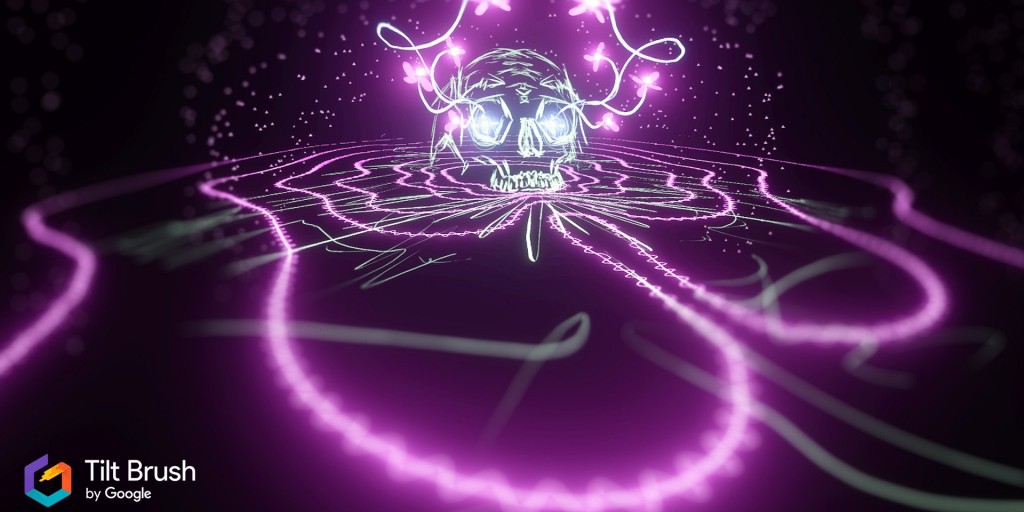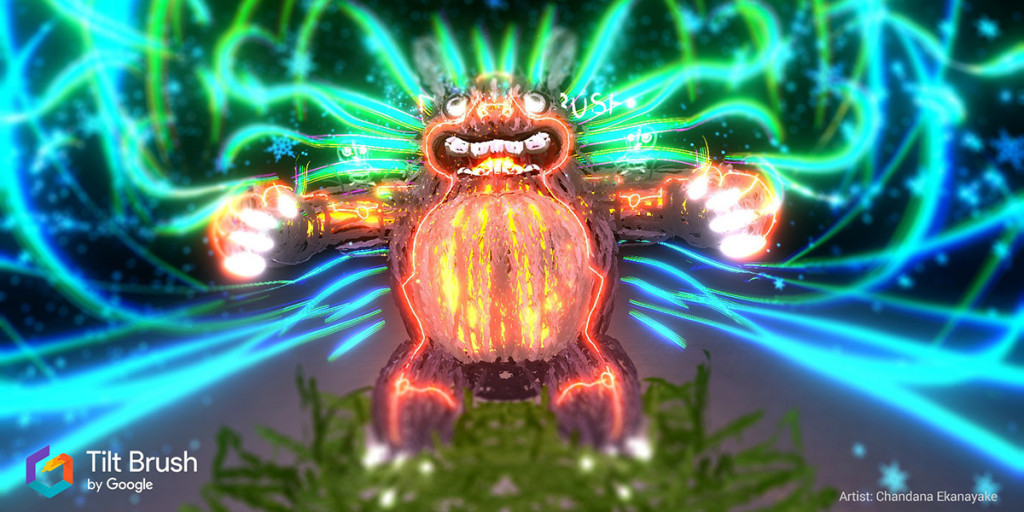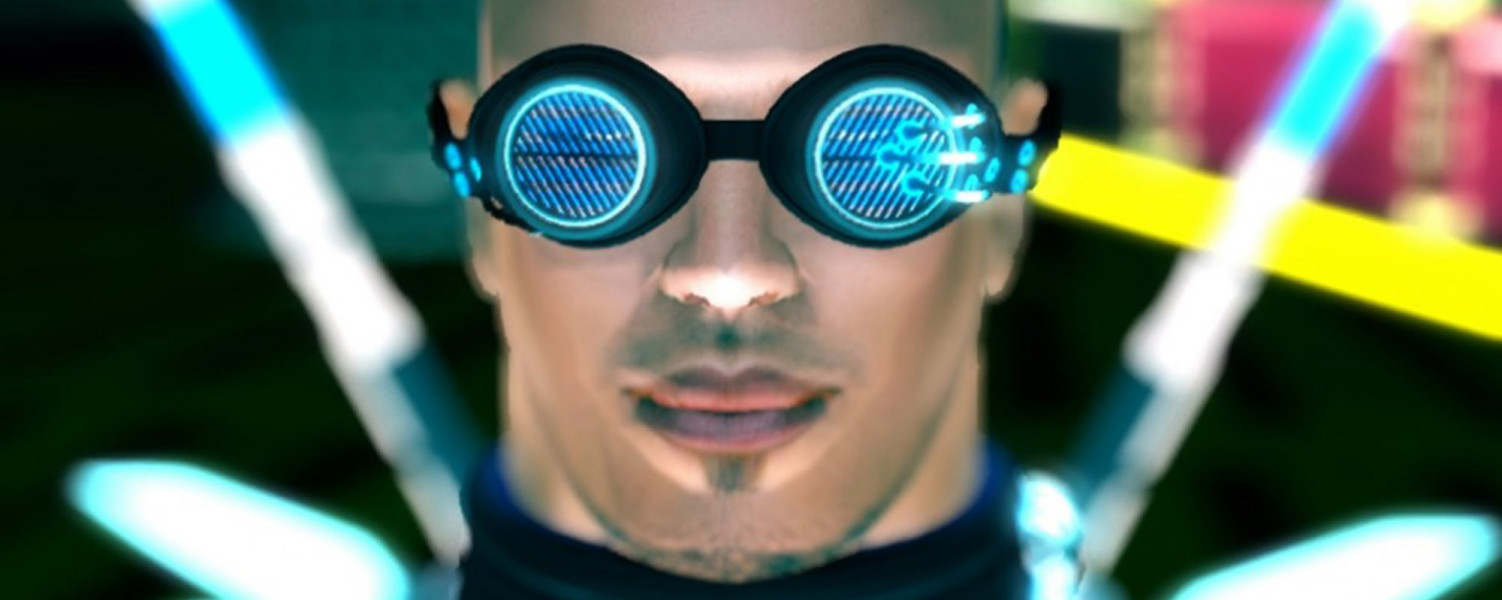This article is part of a collaboration with iQ by Intel.
The advent of the internet created a whole new mode of self-expression, from digital and gif art to fan-fiction and fan art. Now, new virtual reality (VR) tools are primed to inspire yet another era of creators, both amateur and professional, by inviting them to step into their own inventions. Nowhere—so far—is the medium’s artistic possibilities more evident than in Tilt Brush, Google’s VR painting app that launched on the HTC Vive in April. “Combined with the newest generation of motion controllers and input technology, VR has the potential to be the most intuitive and natural creation platform artists have ever experienced,” said Drew Skillman, who together with his partner Patrick Hackett, created Tilt Brush in their San Francisco-based design studio Skillman & Hackett before selling it to Google last year.
The app transforms a pair of motion-tracking controllers into fluid and dynamic paintbrushes, allowing users to paint luminous 3D masterpieces like no other. Brushstrokes levitate in midair, and the Vive’s position tracking cameras allow digital artists to move through the canvas while painting with beams of light in every direction around them. Praise for Tilt Brush has been widespread and feverish. Recently, Fast Company called it “the first great VR app,” seeing it as the perfect introduction to this new world of possibilities. Skillman agrees.“The stars have aligned and VR is finally coming into its own,” he said.

Creativity Begets Creativity
Skillman’s emphasis on fate is apt given the ideation of Tilt Brush happened almost by accident. In 2012, Skillman and Hackett were both employed at Double Fine Productions, the game studio helmed by renowned point-and-click adventure designer Tim Schafer. They were fascinated by the latest gaming gadgets, so they banded together under the sarcastic title Department of Future Tech in order to spend 10 percent of their time on wild experiments. Experiments in the Department of Future Tech included duct-taping Razer Hydra motion controllers to their foreheads to enable mobile games to track their body positions. When Skillman and Hackett decided to combine an Oculus VR headset with the Kinect’s motion-sensing camera on a whim, they were amazed by the results.
“It was a window into what was really going to happen [in] the next five to eight years,” said Hackett. Having seen a glimpse of the future, the two resigned from Double Fine and formed their own company. Among other things, their focus was on developing technology that could give VR users a sense of having a body inside a virtual simulation. “We really stumbled into VR painting by accident through our work on different VR and augmented reality interactions,” said Skillman. “While debugging a prototype, [we] started drawing lines in space. We were mesmerized instantly.”
Skillman and his partner weren’t the only ones who were mesmerized, either. Since Tilt Brush’s inception, a flurry of leading cartoonists and animators have rallied behind the technology’s almost magical concept. Among them are Glen Keane, best known for his animation work on Disney’s The Little Mermaid (1989) and Aladdin (1992), and Chris Prynoski of Adult Swim fame. Many big-name artists have already produced a tremendous number of painterly compositions in VR, inspiring Tilt Brush’s creators and amateurs alike.“It’s amazing to work alongside these artists and watch their VR paintings grow and mature as Tilt Brush evolves,” said Skillman. “In many ways, we feed off of each other’s creative energy.”

Out with the Old…
Skillman believes this technology is the tip of the virtual iceberg. “With Tilt Brush, we’re doing our best to throw out the old ‘keyboard and mouse’ paradigms that we’ve all grown accustomed to, but we’re still in the early stages of that transition.” While it may be strange to think of standard computer equipment as old fashioned, according to leading technological innovators, VR has big implications for the type of digital creations people will be making in the future.
“Tools like Maya [the 3D computer graphics software] have been highly tuned and optimized for doing modeling and creation on the PC for many, many years,” said Ebbe Altberg, CEO of Linden Lab, creators of the virtual world Second Life (2003). “It will take a while for VR to [do similar things] effectively.” Before the artistic singularity can happen, the tools to create these wonderful worlds will need to develop more. “But VR is extremely powerful because you have a complete sense of space and scale that you do not have looking at the PC,” Altberg added. Despite the room for improvement, companies are already bringing new artist-driven technologies to market. Planned to launch in the latter half of 2016, Linden Lab’s next virtual world, codenamed Project Sansar, will put a big emphasis on creating inside VR. With a sweep of their hand, users will be able to redesign their virtual home or toss boulders around on Mars, Altberg said.
Elsewhere, the VR building game Fantastic Contraption allows players to pull tools out of shortcuts on their body. To assemble a simple machine in the game, for instance, a user might grab a rod from over their shoulder, two wheels off the side of their hip, then snap them all together. Similarly, the next version of the game-making tool Unreal Engine 4 allows VR creators to fashion worlds with a pair of lightsaber-esque utensils. While tools such as these will enable a vast array of artistic expression to exist within VR, the art is not necessarily confined to imaginary places. Altberg hints at a porous boundary between the real and virtual, where makers can send their creations back and forth across the digital divide. Altberg foresees fashion brands jumping on the VR bandwagon, as well as other physical and virtual world crossover projects. “Our belief is that VR will ultimately impact pretty much everything,” he said.
